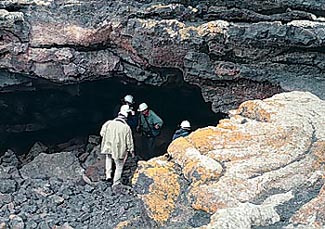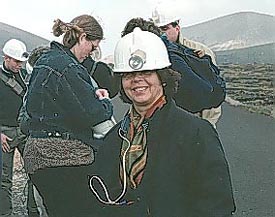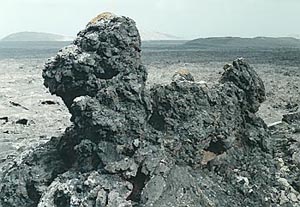When guided, you may want to (or be delighted to) see the caves from the inside. Apparently, this is going to happen right here. This cave is the one which is very well known and frequently visited. It is a mile long walk in the dark.
.
.
Therefore, you have to wear a helmet with a battery powered lamp; a helmet which my wife shows already on her head. The groups consists strictly of 16 persons. In my group one person did not visit the cave. Guess who this was?
.
Everybody who visits the park comes to visit this natural monument. The question put to us and now to you is: what kind of animal is this according to you?
.
As you have already noticed, we have seen lots of inorganic structures related to lava and volcanic masses. You rightly ask yourself whether this is a dead island? And of course, you say NO without any hesitation. It couldn't be a dead island. On our planet Earth, it is almost impossible to imagine and also to find a sterile piece of earth! It was probably the case four and a half billion years ago but not in this era of our green planet which possesses an atmosphere and liquid water. You may ask: where is the water in this dry land with almost no rain to mention?
I looked at the hygrometer for the relative humidity in the city Puerto del Carmen where I had a lodge and I found that it was about 65%. So, the air was not really dry. The condensation of the humidity from the air is one of the factors that can help life to flourish at the microscopic scale. Secondly, there is water still buried deep in the soil, even in this volcanic black earth. Any seed of life which can develop with a minimal amount of water may be supported, and that is absolutely the case in this barren land. Look at the following images and find your answer there.
.
A piece of lava stone (about 30 cm in size) containing numerous small cavities on the surface.
.

A flat form of various types of lichens represented as different colours can be found on the rather smooth surfaces of the rocks.



